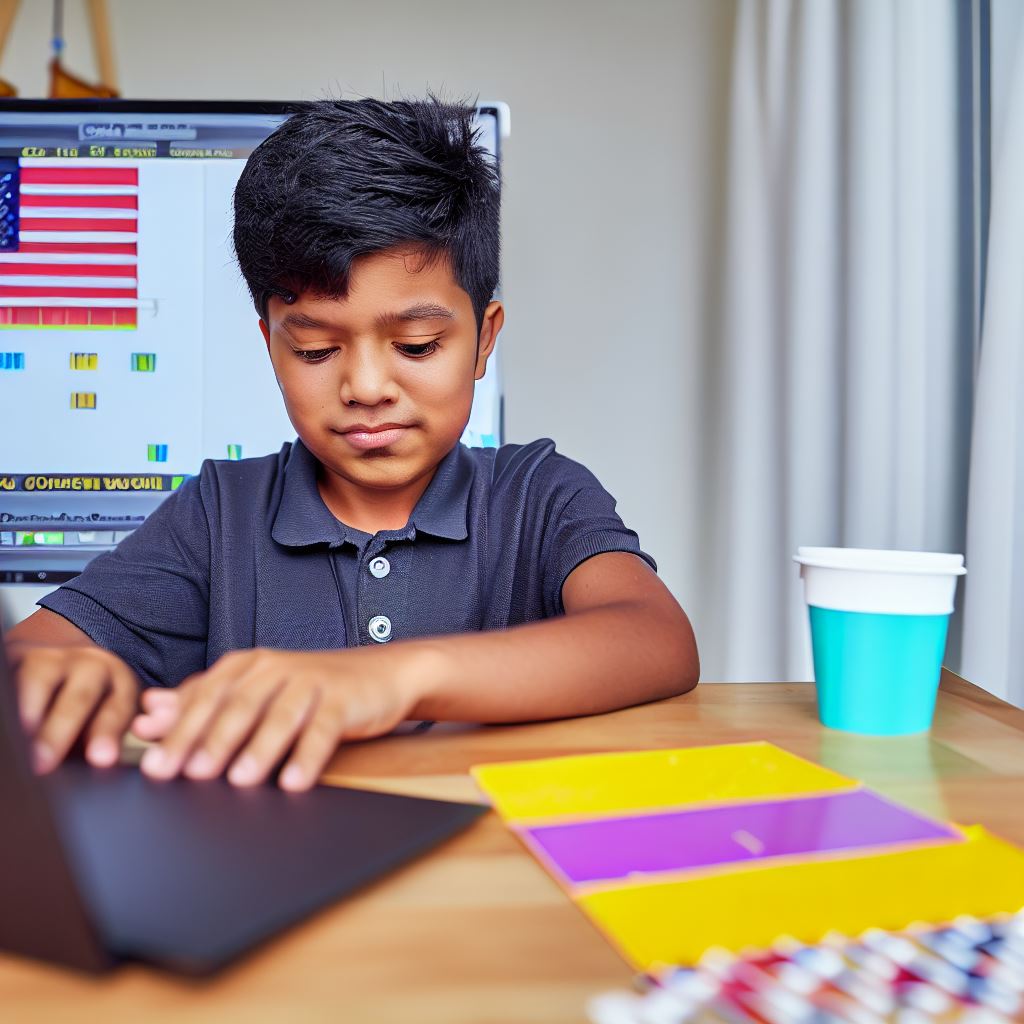Introduction
Scratch is a visual programming language that enables users to create interactive stories, games, and animations.
It encourages critical thinking and creativity by providing a platform for users to express their ideas through coding.
Critical thinking involves analyzing, evaluating, and synthesizing information, while creativity is the ability to come up with unique and original ideas. Both skills are essential in today’s rapidly evolving world.
Scratch promotes critical thinking by challenging users to solve problems through logical reasoning.
By breaking down complex tasks into smaller steps, users learn to think critically and develop problem-solving skills.
Additionally, Scratch encourages creativity by allowing users to explore their imagination and bring their ideas to life.
Through coding, users can design characters, create animations, and compose music. This creative freedom fosters innovation and expression.
One of the key features of Scratch is its visual interface, which makes coding accessible to users of all ages and backgrounds.
This visual aspect helps users to understand programming concepts and encourages them to experiment and explore different possibilities.
Furthermore, Scratch provides a supportive online community where users can share their projects, collaborate, and receive feedback.
This feedback loop enhances critical thinking and creativity by allowing users to reflect on their work and make improvements.
In general, Scratch is an effective tool for promoting critical thinking and creativity.
Its visual programming language, problem-solving challenges, and creative freedom empower users to think critically, generate new ideas, and express themselves through coding.
By using Scratch, individuals can develop essential skills that are applicable across various domains and industries.
Understanding Critical Thinking
Critical thinking is the process of analyzing information objectively and making reasoned judgments. It is an essential skill in today’s fast-paced and complex world.
Tech Consulting Tailored to Your Coding Journey
Get expert guidance in coding with a personalized consultation. Receive unique, actionable insights delivered in 1-3 business days.
Get StartedDeveloping critical thinking skills allows individuals to evaluate arguments, solve problems, and make informed decisions.
The Importance of Critical Thinking
Critical thinking is crucial as it helps individuals make sense of the vast amount of information available to them. It enables them to distinguish between fact and opinion, identify biases, and question assumptions.
Critical thinking is not about accepting everything at face value; it encourages individuals to be sceptical and seek evidence.
How Scratch Prompts Users to Think Critically
Scratch is a platform that allows users to create interactive stories, games, and animations. It prompts users to think critically by engaging them in problem-solving activities.
When using Scratch, users face challenges and must find creative solutions to achieve their desired outcomes.
Examples of Critical Thinking Skills Developed through Scratch
- Problem Identification: Scratch users learn to identify problems in their projects and define clear objectives.
- Analysis and Evaluation: Users analyze different options and evaluate which solution best suits their needs.
- Logical Thinking: Scratch requires users to think logically and plan out their projects step by step.
- Experimentation and Revision: Users experiment with different coding blocks, revise their projects, and learn from their mistakes.
- Collaboration and Communication: Scratch encourages users to share their projects, seek feedback, and collaborate with others to improve their skills.
- Reflection and Self-Correction: Users reflect on their projects, identify areas for improvement, and make necessary revisions.
- Creativity and Innovation: Scratch provides a platform for users to think creatively, come up with unique ideas, and bring them to life through coding.
- Problem-solving: Users encounter technical challenges while using Scratch and develop problem-solving skills to overcome them.
- Iterative Thinking: Scratch projects often involve multiple iterations, allowing users to refine their ideas and solutions over time.
- Risk-taking: Scratch encourages users to take risks and push the boundaries of their creativity, fostering a growth mindset.
- Attention to Detail: Users learn to pay attention to the smallest details of their projects, ensuring their designs and code work seamlessly.
- Adaptability: Scratch users adapt to changes in their projects and find alternative solutions when faced with obstacles.
In conclusion, Scratch not only enables users to develop programming and coding skills but also fosters critical thinking and creativity.
Through problem-solving, collaboration, and reflection, users acquire essential skills that extend beyond the Scratch platform.
These skills prepare them to navigate the complexities of the digital world and equip them to think critically in various aspects of their lives. So, dive into Scratch and unlock your critical thinking potential today!
Read: From Scratch to Python: Transitioning to Text-based Coding

Fostering Creativity
Creativity, the ability to generate new ideas, is essential in today’s constantly evolving world. It allows individuals to think outside the box and come up with innovative solutions.
In this section, we will discuss the significance of creativity and how Scratch, a programming language, encourages creative thinking.
We will also provide examples of creative projects on Scratch that showcase the diverse possibilities it offers.
Creativity and its significance
Creativity is the process of unleashing one’s imagination and originality to create something unique. It goes beyond conventional thinking and pushes boundaries.
In today’s complex world, creativity is highly valued as it leads to advancements in various fields, including technology, arts, and sciences.
Build Your Vision, Perfectly Tailored
Get a custom-built website or application that matches your vision and needs. Stand out from the crowd with a solution designed just for you—professional, scalable, and seamless.
Get StartedIt allows individuals to express themselves, solve problems, and make a lasting impact.
How Scratch encourages creative thinking
Scratch is a block-based visual programming language that fosters creativity in several ways.
Firstly, it provides a user-friendly platform suitable for beginners, enabling them to explore and experiment with coding concepts.
This hands-on approach sparks creativity by allowing users to bring their ideas to life through interactive stories, games, and animations.
Additionally, Scratch offers a wide range of programming blocks and features that can be combined in unique ways.
This flexibility encourages users to think creatively and find innovative solutions to create their projects. It promotes problem-solving skills and pushes users to think critically about the logic behind their creations.
Examples of creative projects on Scratch
1. Interactive Stories
Scratch allows users to create interactive stories with branching paths and engaging characters.
For example, a user could develop a Choose Your Own Adventure-style story where the reader’s decisions determine the plot’s outcome.
This project encourages creativity through storytelling and enables users to explore different narrative possibilities.
2. Artistic Animations
Scratch provides a platform for users to animate their artistic creations. Users can design and program their characters, setting them in motion with various coding blocks.
By combining visual elements, sounds, and animations, users can create unique and imaginative artworks, expressing their creativity in a visually captivating manner.
3. Educational Games
Scratch can be used to develop educational games that make learning fun and interactive. For instance, a user can create a math game where players solve equations to advance.
This project not only reinforces mathematical concepts but also encourages creativity in designing engaging levels and challenges.
4. Music and Dance Projects
Scratch enables users to compose their music and choreograph dance routines using programming blocks.
Optimize Your Profile, Get Noticed
Make your resume and LinkedIn stand out to employers with a profile that highlights your technical skills and project experience. Elevate your career with a polished and professional presence.
Get NoticedUsers can experiment with rhythms, melodies, and dance moves, allowing them to express their artistic side and create original performances.
Creativity plays a vital role in today’s world, and Scratch provides a platform that encourages creative thinking.
By offering a user-friendly interface, flexible programming blocks, and a diverse range of projects, Scratch enables users to unleash their creativity and explore their ideas.
The examples provided showcase the limitless possibilities that Scratch offers, empowering individuals to think critically and create innovative projects.
Start coding with Scratch today and see where your creativity takes you!
Read: Introduction to Python: Starting Your Coding Journey
Promoting Problem-solving Skills
In today’s fast-paced and tech-driven world, critical thinking and creativity have become essential skills.
These skills empower individuals to confront challenges, find innovative solutions, and adapt to an ever-changing environment.
The visual programming language, Scratch, exemplifies fostering critical thinking and creativity through problem-solving.
Scratch: Unlocking Creativity and Critical Thinking
Scratch is an intuitive platform designed to introduce programming concepts to users of all ages.
Its user-friendly interface and block-based coding system enable beginners to explore their creative potential while developing essential problem-solving skills.
From a young age, users are encouraged to think analytically and critically to create interactive projects.
Coding with Scratch: A Journey of Problem-solving
Throughout the coding process, Scratch presents users with various challenges that require problem-solving skills.
From designing unique characters to creating complex animations, every step demands critical thinking and creativity.
Users learn to analyze problems, break them down into smaller parts, and devise strategies to achieve their desired outcomes.
As users encounter obstacles, they must think critically and devise alternative solutions.
This iterative process stimulates their problem-solving skills and encourages them to explore different approaches to overcome difficulties.
Scratch’s open-ended nature allows users to experiment, fail, and learn from their mistakes, further enhancing their problem-solving abilities.
The Importance of Problem-solving Skills in Creating Complex Scratch Projects
Creating complex projects on Scratch requires advanced problem-solving skills. Users must envision the desired outcome and break it down into manageable steps.
They need to think critically, understand possible challenges and anticipate the solutions required to overcome them.
Problem-solving skills are fundamental in addressing coding errors, debugging programs, and optimizing performance. Users develop resilience and perseverance, crucial traits when tackling complex projects.
Over time, they become adept at troubleshooting, finding elegant solutions, and refining their projects through critical thinking.
Success Stories: How Scratch Developers Become Problem-solving Experts
The impact of Scratch in fostering problem-solving skills cannot be overstated. Numerous success stories showcase the transformation of novices into proficient problem solvers.
For instance, Emma, a 12-year-old Scratch enthusiast, started with simple animations and gradually expanded her projects.
Emma faced countless challenges that required her to employ critical thinking and creativity.
Through persistence and determination, she discovered alternative approaches and incorporated more complex functionalities into her projects.
Today, she creates interactive games with intricate gameplay mechanics, demonstrating her exceptional problem-solving abilities.
Another inspiring success story is Mark, a university student majoring in computer science. Mark’s journey began with Scratch, where he honed his problem-solving skills.
The iterative process taught him to analyze problems from multiple angles, evaluate potential solutions, and celebrate breakthroughs.
Thanks to Scratch, Mark developed a robust problem-solving mindset, which greatly benefited him in his university studies.
His ability to approach complex coding problems with creativity and critical thinking propelled him to excel academically and secure internships at renowned tech companies.
In summary, Scratch is a powerful platform that promotes critical thinking and creativity through problem-solving.
From beginners to experts, users are consistently challenged to think analytically, break down problems, and devise innovative solutions.
By cultivating problem-solving skills with Scratch, users unlock their creative potential and prepare themselves for the challenges of our increasingly digital world.
Read: Improve Problem-Solving Skills: Coding Games for Pros
Collaborative Learning on Scratch
Scratch, an online platform, facilitates collaboration among users through shared projects and online communities.
Users can access and remix each other’s projects, inviting a culture of collaboration and creativity.
By providing a platform that allows users to collaborate on projects, Scratch promotes critical thinking as users learn from one another’s ideas and perspectives.
The online platform also supports real-time collaboration, enabling users to work together on projects simultaneously.
Benefits of collaborative projects on Scratch
Collaborative projects on Scratch offer numerous benefits, including the development of critical thinking and problem-solving skills.
Through collaboration, users gain exposure to diverse perspectives, fostering creativity and innovation.
Working collaboratively allows users to learn from their peers, leading to a deeper understanding of coding concepts and techniques.
Collaboration also encourages teamwork and communication skills, as users must effectively communicate and coordinate their efforts.
In collaborative projects, users can explore new ideas and approaches, expanding their knowledge and horizons.
Examples of successful collaborative projects on Scratch
One example of a successful collaborative project on Scratch is the “Journey to the Stars” game.
Developed by a team of four users, this project utilized each member’s strengths and skills to create an engaging and interactive game.
The collaboration involved brainstorming ideas, dividing tasks, and providing feedback to improve the project’s overall quality.
Another example is the “Global Art Gallery” project, where users from different countries worked together to create an online art gallery.
Each user contributed artwork, descriptions, and multimedia elements, showcasing diverse artistic styles and cultural perspectives.
The project not only celebrated creativity but also fostered cultural understanding and appreciation.
Collaboration on Scratch provides a unique learning experience, encouraging critical thinking and creativity.
By collaborating with others, users can expand their knowledge, learn new skills, and gain valuable insights.
Through collaborative projects, users develop problem-solving abilities, as they must work together to overcome challenges.
Moreover, collaborating enhances communication and teamwork skills, preparing users for future collaborative endeavors.
The ability to collaborate is a vital skill in today’s interconnected world, and Scratch provides an ideal platform to nurture this skill.
Essentially, Scratch’s online platform enables collaborative learning, promoting critical thinking and creativity.
By allowing users to work together on projects, Scratch fosters a culture of collaboration and innovation.
Collaborative projects on Scratch offer numerous benefits, including the development of critical thinking and problem-solving skills.
Successful collaborative projects on Scratch showcase the power of teamwork and diversity in creating meaningful and engaging projects.
Collaborating on Scratch provides a unique learning experience, expanding users’ knowledge, skills, and perspectives.
With its emphasis on collaboration, Scratch prepares users for success in an increasingly interconnected and collaborative world.
Read: Master Python Through These Addictive Coding Games
Conclusion
In conclusion, Scratch is an exceptional platform that actively encourages critical thinking and creativity.
Through its interactive and engaging interface, Scratch motivates users to think analytically, problem-solve, and explore innovative solutions.
By designing animations, stories, games, and interactive projects, users are prompted to think critically and creatively about programming concepts and design principles.
These skills are invaluable in the 21st century, where innovation and adaptability are highly sought after.
Critical thinking allows individuals to analyze situations, make informed decisions, and find solutions to complex problems.
Creativity, on the other hand, enables them to conceptualize and develop innovative ideas that reshape the world.
The combination of critical thinking and creativity not only enhances cognitive abilities but also fosters personal growth and development.
These skills empower individuals to become lifelong learners, capable of tackling any challenge they encounter.
Therefore, it is highly encouraged for readers to explore Scratch and experience its benefits firsthand.
By engaging with Scratch, individuals can develop their critical thinking and creativity skills, equipping themselves for success in the increasingly complex and competitive landscape of the 21st century.
So why wait? Start your Scratch journey today and unlock your full potential!




